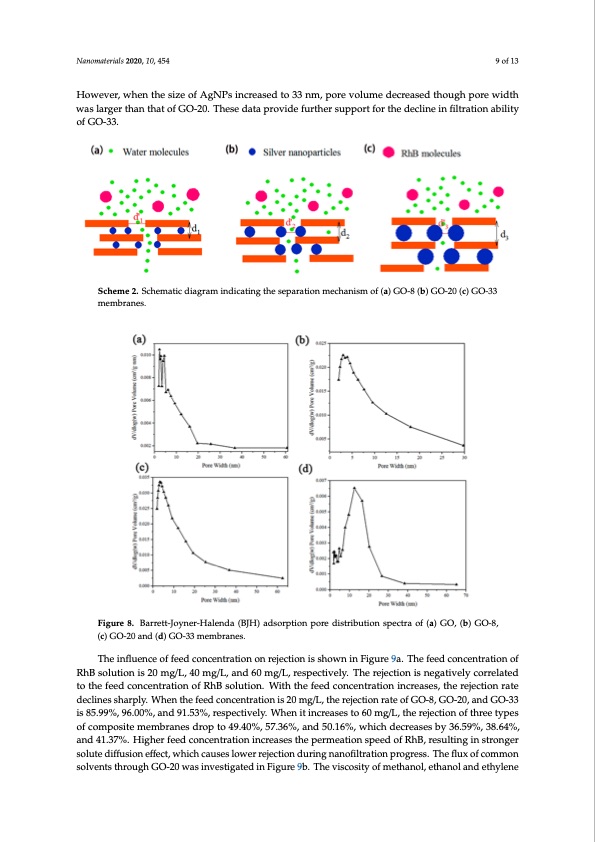
PDF Publication Title:
Text from PDF Page: 009
Nanomaterials 2020, 10, 454 Nanomaterials 2020, 10, x FOR PEER REVIEW 9 of 13 Nanomaterials 2020, 10, x FOR PEER REVIEW 10 of 14 HHowowevevverer,r, w,whenentththessiizizeeooffAgNPss iincreased tto 3nm,,poorreevvoolulumeedececrcrereaeasasesededthtthohouougughghppoporoerrewe widiidtdhtth wwaasassllaalrargrgegererrtththaanantththaatttooffGO--2-200..These data proviideffurtthersuporrtrttffoforrtththeeddeececlcilnliineneiniinfifilftilrltatrrtaitotiinonabaibliitllyiitty o ofof GfGGO O O--3 3-3 3 3.3. . 10 of 14 Scheme 2. Schematic diagram indicating the separation mechanism of (a) GO-8 (b) GO-20 (c) GO-33 Scheme 2. Schematic diagram indicating the separation mechanism of (a) GO-8 (b) GO-20 (c) GO-33 Scheme 2. Schematic diagram indicating the separation mechanism of (a) GO-8 (b) GO-20 (c) GO-33 membranes. membranes. membranes. Figure 8. Barrett-Joyner-Halenda (BJH) adsorption pore distribution spectra of (a) GO, (b) GO-8, (c) GO-20 and (d) GO-33 membranes. Fiigurree8.. Barrettt--JJoynerr--Halleendaa(B(BJHJH))aaddsosorprptitoionnpporoeredidsitsrtibriubtuiotinonspsepcetrcatroafo(fa)(aG)OG,O(b,)(bG)OG-8O,-(8c,) (Gc)OG-O20-2a0nadn(d)(dG)OG-O33-3m3 emebmrabnraens.es. The influence of feed concentration on rejection is shown in Figure 9a. The feed concentration of RhBTshoeluintiflouneinsc2e0omf gfe/eLd, 4c0omncge/nLt,rantidon60onmrge/jLe,crtieosnpeisctsivheolwy.nTihneFriegjeucrteio9na.isTnheegfaeteivdelcyoncocerrnetlratteidontoof The influence of feed concentration on rejection is shown in Figure 9a. The feed concentration of the feed concentration of RhB solution. With the feed concentration increases, the rejection rate RhB solution is 20 mg/L, 40 mg/L, and 60 mg/L, respectively. The rejection is negatively correlated RhB solution is 20 mg/L, 40 mg/L, and 60 mg/L, respectively. The rejection is negatively correlated to declines sharply. When the feed concentration is 20 mg/L, the rejection rate of GO-8, GO-20, and GO- to the feed concentration of RhB solution. With the feed concentration increases, the rejection rate the feed concentration of RhB solution. With the feed concentration increases, the rejection rate 33 is 85.99%, 96.00%, and 91.53%, respectively. When it increases to 60 mg/L, the rejection of three declines sharply. When the feed concentration is 20 mg/L, the rejection rate of GO-8, GO-20, and GO-33 declines sharply. When the feed concentration is 20 mg/L, the rejection rate of GO-8, GO-20, and GO- types of composite membranes drop to 49.40%, 57.36%, and 50.16%, which decreases by 36.59%, is 85.99%, 96.00%, and 91.53%, respectively. When it increases to 60 mg/L, the rejection of three types 33 is 85.99%, 96.00%, and 91.53%, respectively. When it increases to 60 mg/L, the rejection of three 38.64%, and 41.37%. Higher feed concentration increases the permeation speed of RhB, resulting in of composite membranes drop to 49.40%, 57.36%, and 50.16%, which decreases by 36.59%, 38.64%, types of composite membranes drop to 49.40%, 57.36%, and 50.16%, which decreases by 36.59%, stronger solute diffusion effect, which causes lower rejection during nanofiltration progress. The flux and 41.37%. Higher feed concentration increases the permeation speed of RhB, resulting in stronger 38.64%, and 41.37%. Higher feed concentration increases the permeation speed of RhB, resulting in of common solvents through GO-20 was investigated in Figure 9b. The viscosity of methanol, ethanol solute diffusion effect, which causes lower rejection during nanofiltration progress. The flux of common stronger solute diffusion effect, which causes lower rejection during nanofiltration progress. The flux and ethylene glycol are 0.60 mPa·s, 1.17 mPa·s, and 19.9 mPa·s, respectively. The flux of methanol, solvents through GO-20 was investigated in Figure 9b. The viscosity of methanol, ethanol and ethylene of common solvents through GO-20 was investigated in Figure 9b. The viscosity of methanol, ethanol and ethylene glycol are 0.60 mPa·s, 1.17 mPa·s, and 19.9 mPa·s, respectively. The flux of methanol,PDF Image | Graphene Oxide Nanofiltration Membranes Silver Nanoparticles

PDF Search Title:
Graphene Oxide Nanofiltration Membranes Silver NanoparticlesOriginal File Name Searched:
nanomaterials-10-00454-v2.pdfDIY PDF Search: Google It | Yahoo | Bing
Turbine and System Plans CAD CAM: Special for this month, any plans are $10,000 for complete Cad/Cam blueprints. License is for one build. Try before you buy a production license. More Info
Waste Heat Power Technology: Organic Rankine Cycle uses waste heat to make electricity, shaft horsepower and cooling. More Info
All Turbine and System Products: Infinity Turbine ORD systems, turbine generator sets, build plans and more to use your waste heat from 30C to 100C. More Info
CO2 Phase Change Demonstrator: CO2 goes supercritical at 30 C. This is a experimental platform which you can use to demonstrate phase change with low heat. Includes integration area for small CO2 turbine, static generator, and more. This can also be used for a GTL Gas to Liquids experimental platform. More Info
Introducing the Infinity Turbine Products Infinity Turbine develops and builds systems for making power from waste heat. It also is working on innovative strategies for storing, making, and deploying energy. More Info
Need Strategy? Use our Consulting and analyst services Infinity Turbine LLC is pleased to announce its consulting and analyst services. We have worked in the renewable energy industry as a researcher, developing sales and markets, along with may inventions and innovations. More Info
Made in USA with Global Energy Millennial Web Engine These pages were made with the Global Energy Web PDF Engine using Filemaker (Claris) software.
Infinity Turbine Developing Spinning Disc Reactor SDR or Spinning Disc Reactors reduce processing time for liquid production of Silver Nanoparticles.
| CONTACT TEL: 608-238-6001 Email: greg@infinityturbine.com | RSS | AMP |